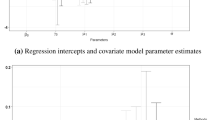Abstract
We develop the non-parametric maximum likelihood estimator (MLE) of the full Mbh capture-recapture model which utilizes both initial capture and recapture data and permits both heterogeneity (h) between animals and behavioural (b) response to capture. Our MLE procedure utilizes non-parametric maximum likelihood estimation of mixture distributions (Lindsay, 1983; Lindsay and Roeder, 1992) and the EM algorithm (Dempsteret al., 1977). Our MLE estimate provides the first non-parametric estimate of the bivariate capture-recapture distribution.
Since non-parametric maximum likelihood estimation exists for submodels Mh (allowing heterogeneity only), Mb (allowing behavioural response only) and M0 (allowing no changes), we develop maximum likelihood-based model selection, specifically the Akaike information criterion (AIC) (Akaike, 1973). The AIC procedure does well in detecting behavioural response but has difficulty in detecting heterogeneity.
Similar content being viewed by others
References
Akaike, H. (1973) Information theory and an extension of the maximum likelihood principle. In: B.N. Petrov and F. Csaki (eds)2nd International Symposium on Information Theory, Akademiai Kiado, Budapest.
Akaike, H. (1981) Likelihood of a model and information criteria.Journal of Econometrics,16, 3–14.
Anderson, D.R., Burnham, K.P. and White, G.C. (1994) AIC model selection in overdispersed capture-recapture data.Ecology,75(6), 1780–93.
Dempster, A.P., Laird, N.M. and Rubin, D.B. (1977) Maximum likelihood estimation from incomplete data via the EM algorithm.Journal of the Royal Statistical Society, Series B, 30, 1–38.
DerSimonian, R. (1986) Maximum likelihood estimation of a mixing distribution.Applied Statistics,35, 301–9.
Lee, S. and Chao, A. (1994) Estimating population size via sample coverage for closed capture-recapture models.Biometrics,50, 88–97.
Lindsay, B.G. (1983) The geometry of mixture likelihoods, a general theory.Annals of Statistics,11, 86–94.
Lindsay, B.G. and Roeder, K. (1992) Residual diagnostics for mixture models.Journal of the American Statistical Association,87, 785–94.
Norris, J.L. and Pollock, K.H. (1995) Nonparametric MLE under two closed capture-recapture models with heterogeneity. In press,Biometrics.
Otis, D.L., Burnham, K.P., White, G.C. and Anderson, D.R. (1978) Statistical inference from capture data on closed animal populations.Wildlife Monographs,62.
Pollock, K.H. (1974) The assumption of equal catchability of animals in tag-recapture experiments. Ph.D. Thesis, Cornell University, Ithaca, NY.
Pollock, K.H. and Otto, M.C. (1983) Robust estimation of population size in closed animal populations from capture-recapture experiments.Biometrics,39, 1035–50.
Author information
Authors and Affiliations
Rights and permissions
About this article
Cite this article
Norris, J.L., Pollock, K.H. A capture-recapture model with heterogeneity and behavioural response. Environ Ecol Stat 2, 305–313 (1995). https://doi.org/10.1007/BF00569360
Received:
Revised:
Issue Date:
DOI: https://doi.org/10.1007/BF00569360




